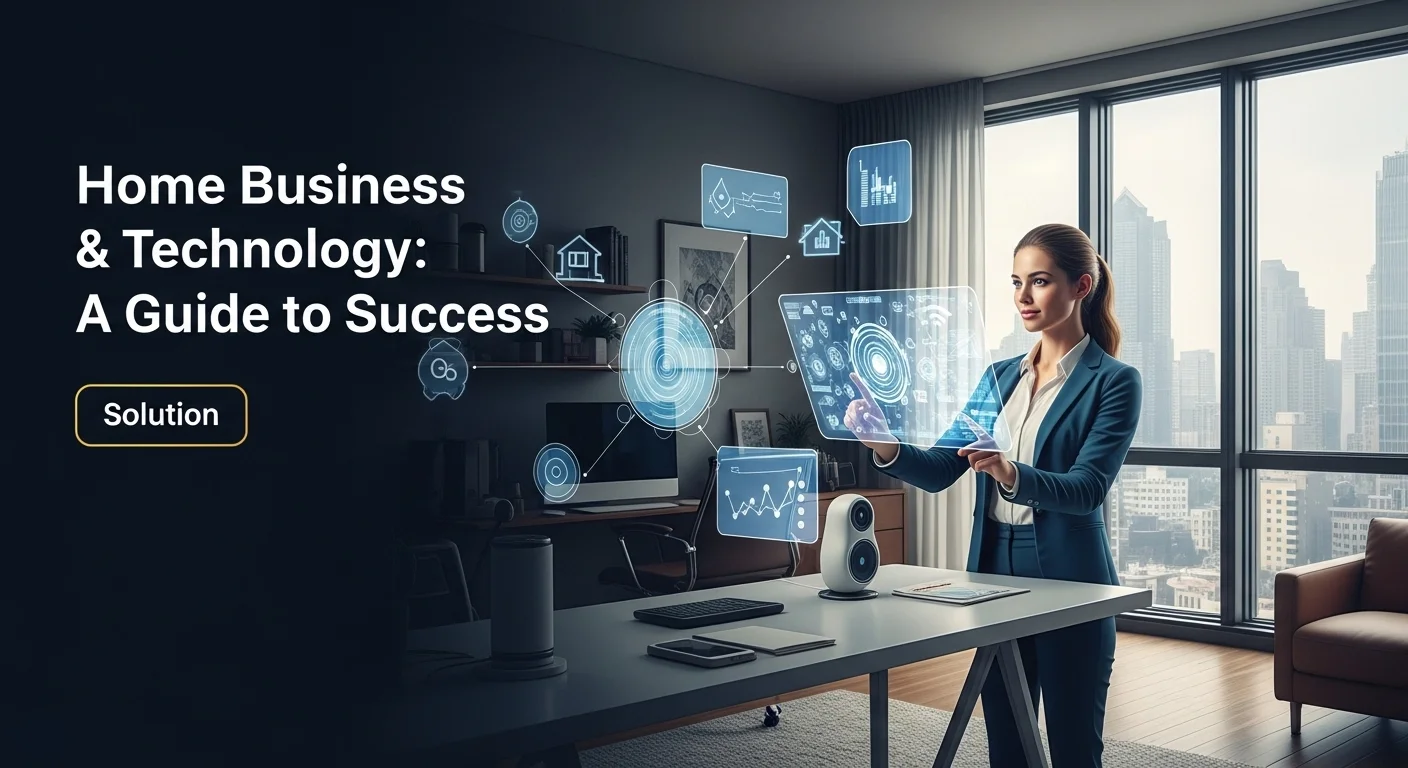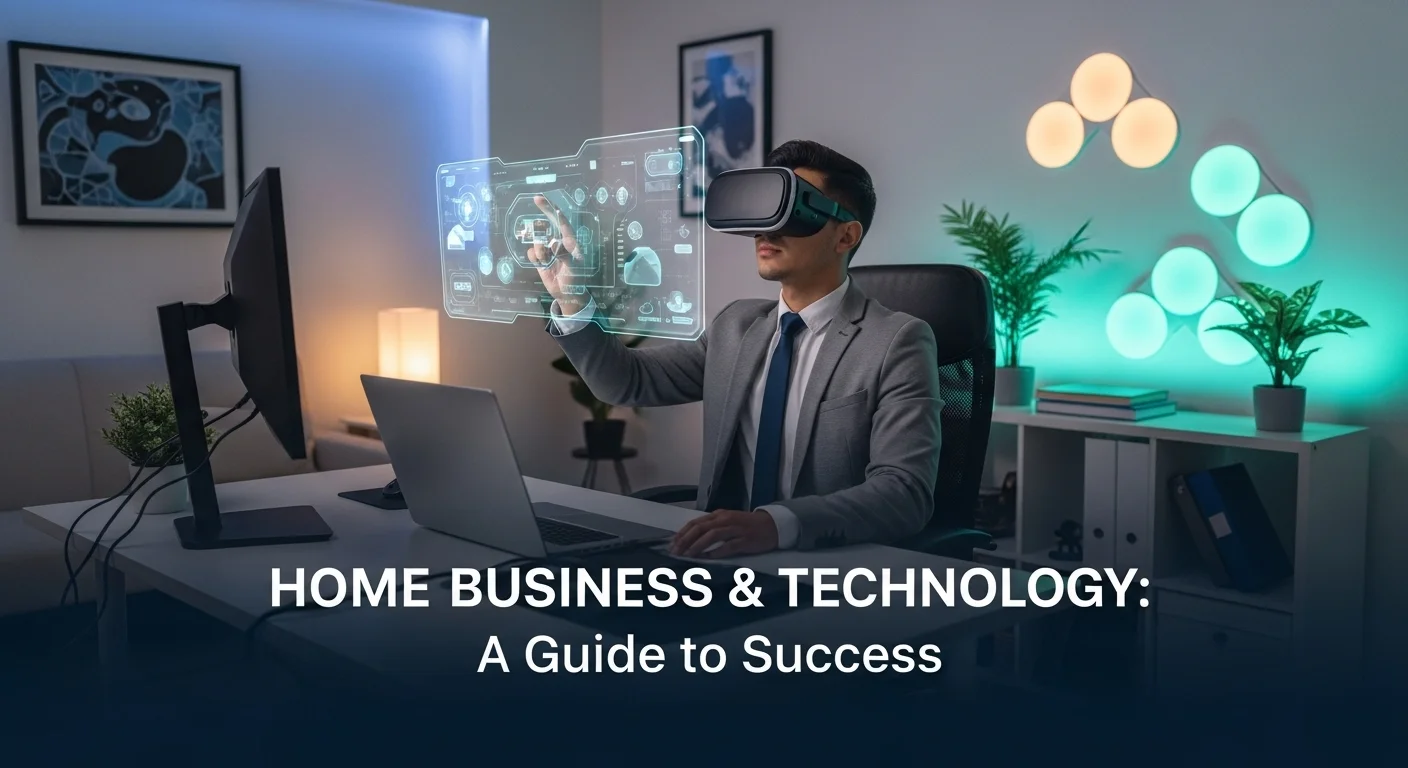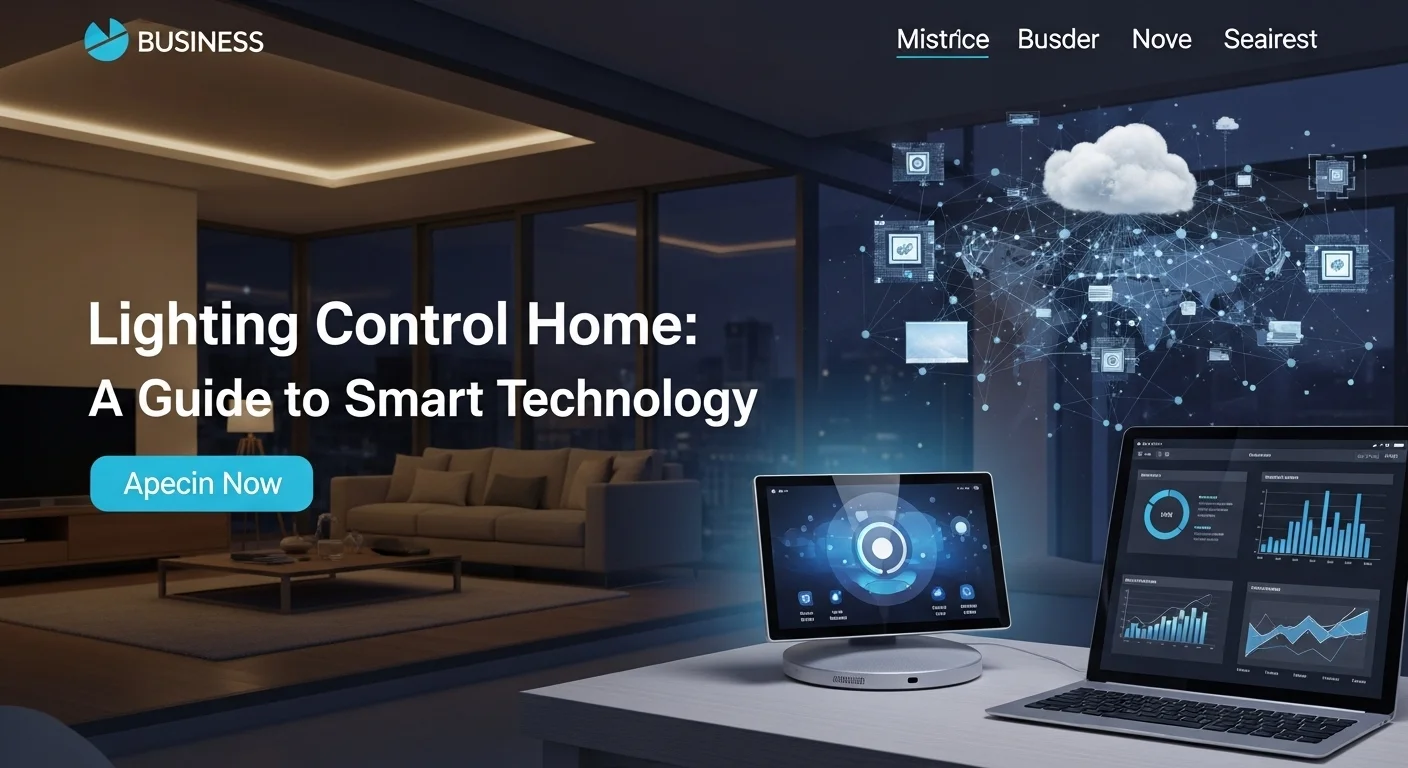Your Home Business Tech Toolkit: A Personal Guide to Success

Executive Summary
The dream of running a business from home has exploded from a niche idea into a powerful movement for entrepreneurs. It's not just about flexibility anymore; it's about building a lean, global, and highly profitable venture. I've spent years in the trenches, helping people just like you navigate the intersection of a great idea and the right technology. This guide is the culmination of that experience. We'll cut through the jargon and get straight to what works: using the cloud for ultimate freedom, locking down your digital world with smart cybersecurity, and leveraging AI to work smarter, not harder. We'll cover everything from the must-have gadgets for your smart office to the software that can give you a real competitive edge. This is your practical, actionable roadmap to building a business you love, right from your home.
Table of Contents
Table of Contents
- What a Modern Home Business Really Is
- The Non-Negotiable Tech Foundation
- The Real-World Benefits of a Tech-First Approach
What a Modern Home Business Really Is (and Why Tech Is Its Heartbeat)
When I first started my own consulting gig from a spare bedroom over a decade ago, the term 'home business' often meant small-time craft sales or local repair services. Today, that picture is completely different. A modern home business can be a global powerhouse, a solo creative agency, or a thriving e-commerce store, all run from a desk in the corner of a living room. The big change? Technology. It's no longer just a helpful tool; it's the very ground the business is built on. The internet and the powerful, affordable tech that comes with it have leveled the playing field, making it possible for anyone with a skill and a solid Wi-Fi connection to build a real, sustainable enterprise.
Getting your head around this is the first, most crucial step. You're not just a baker working from home anymore; you're an e-commerce entrepreneur using online ordering systems, digital marketing, and logistics software. You're not just a writer; you're a content strategist using AI assistants, SEO tools, and global payment platforms. I've seen it time and again: the businesses that truly succeed are the ones that embrace this deep integration of technology. It’s what separates a profitable venture from a hobby and allows small home businesses to be more agile and competitive than their larger, slower-moving corporate counterparts.
The Non-Negotiable Tech Foundation
To build something that lasts, you need a strong foundation. In the digital world, that foundation is made of a few key technological components. These aren't optional extras; they're the absolute must-haves for anyone serious about building a successful business from home.
1. Rock-Solid Internet: This is your digital storefront, your communication line, and your connection to the world. Think of it like the location of a physical store. A slow or spotty connection can shut down your entire operation, from client video calls to processing payments. I always advise new entrepreneurs: don't skimp here. Investing in a reliable, business-grade internet service isn't an expense; it's an investment in keeping your doors open.
2. The Right Hardware: Your computer is your command center. Whether it's a beast of a desktop for creative work or a sleek laptop for mobility, it has to be powerful enough for the job. Using an old, slow machine is a recipe for frustration and lost productivity. Don't forget the peripherals, either. A good monitor, an ergonomic keyboard, and a quality webcam make you more productive and look more professional.
3. The Power of the Cloud: Honestly, the cloud has been the single biggest game-changer for home businesses. Services like Google Workspace and Microsoft 365 give you professional-grade tools for a small monthly fee. [2] Cloud storage like Dropbox or Google Drive means your critical files are safe from a hard drive crash and accessible from anywhere. [2] This freedom and security are the essence of the modern home business. It eliminates risk and lets you work from anywhere, which is what this lifestyle is all about.
4. Smart Cybersecurity: When your home is your office, your personal network is your business network, and that makes you a target. Cybercriminals love going after small businesses because they often assume security is lax. A single breach can be devastating. The basics are non-negotiable: use a password manager for strong, unique passwords, turn on two-factor authentication (2FA) everywhere, install good antivirus software, and secure your Wi-Fi with a strong password. [16, 25] Think of a firewall as the bouncer for your digital club—it decides who gets in and who stays out. [25]
The Real-World Benefits of a Tech-First Approach
With that foundation in place, you can start using technology to actively grow your business. This is where the magic happens. The most obvious win is the huge reduction in costs. [20] No office rent, no commuting, no massive utility bills. This frees up cash that you can pour back into marketing, product development, or even better tech.
Technology also gives you a global megaphone. An artist in a small town can sell to customers in Tokyo. A consultant can advise clients in London over Zoom. This kind of market access was pure fantasy for small businesses just a generation ago. It’s why so many home-based ventures have such high earning potential today.
Finally, there’s the massive boost to your personal productivity. Project management tools like Trello or Asana keep you organized. Accounting software like QuickBooks automates the boring stuff like invoicing and expense tracking. Customer Relationship Management (CRM) systems, which used to be for big corporations, now have free or affordable versions (like HubSpot's) that help you manage your client relationships like a pro. [7, 24]
And now, Artificial Intelligence (AI) is like adding a supercharger to your engine. AI tools can help write marketing copy, analyze data, and even handle basic customer service, acting as a virtual assistant that frees you up to focus on the big picture. [18, 19] For anyone wanting to build a truly successful home business in this decade, learning to leverage these tools isn't just an advantage; it's essential.

A Practical Guide to Your Home Business Tech and Strategy
Embarking on your own home business journey is incredibly exciting. The promise of freedom and building something of your own is a powerful motivator. But I've learned from experience that a great idea is only half the battle; success comes from strategically using the right technology. This guide is your roadmap. We’ll get down to the practical steps and explore the business models that are thriving right now, turning your vision into a profitable reality.
Choosing Your Tech-Powered Business Model
First things first, you need a business model that fits your skills and the market. Technology has blown the doors open on what's possible from home. Here are some of the models I see succeed most often:
1. E-commerce and Dropshipping: Selling products online is a classic for a reason. You can create your own unique items or source them from others. If you're looking for a low-risk way to start, dropshipping is fantastic. You run the online store and handle the marketing, while someone else manages the inventory and shipping. [33]
* Your Go-To Platforms: Shopify, BigCommerce, WooCommerce, Etsy, Amazon.
* Essential Tech: A solid e-commerce platform, trusted payment gateways (Stripe, PayPal), and smart email marketing tools like Klaviyo or Mailchimp.
2. Freelance Services & Consulting: If you've got a professional skill, the world is your market. This is often the fastest way to start earning from home.
* Hot Fields: Digital Marketing (SEO, social media), Web Development, Writing and Editing, Graphic Design, and Virtual Assistance (VA). [36, 42, 46]
* Essential Tech: A professional portfolio website, proposal software like PandaDoc, project management tools like Asana, and communication hubs like Slack and Zoom.
3. Digital Products and Content Creation: This is about building an audience around your expertise and then monetizing it. It's a powerful model because you create something once and can sell it over and over.
* How It Works: Blogging, creating a YouTube channel, or starting a podcast. You earn from ads, affiliate links, and selling your own digital products like e-books, online courses, or design templates. [33]
* Essential Tech: A content platform like WordPress, video/audio editing software like Descript, and a platform to sell your products like Kajabi or Gumroad.
4. Software as a Service (SaaS): If you have coding skills, this can be the holy grail due to its recurring revenue model. [46] You build a software solution for a specific problem and charge a subscription.
* Think About: Niche project management tools, specialized analytics apps, or a custom CRM.
* Essential Tech: Cloud hosting (AWS, Google Cloud), programming frameworks, and subscription management services like Stripe.
Setting Up Your Tech Infrastructure: A Step-by-Step Guide
Once you've picked your path, it's time to build your digital office. This is more than just buying a computer.
Step 1: Lock Down Your Network. Your home network is now your corporate network. Treat it that way. [21]
* First thing: Change the default admin login on your Wi-Fi router.
* Enable WPA3 encryption. It's the current security standard.
* Create a Guest Network. All your personal smart devices (TVs, speakers) go on this. Your business computer stays on the main, more secure network.
* Use a VPN (Virtual Private Network). A VPN encrypts your traffic, keeping you safe, especially if you ever work from a coffee shop. [16, 28]
Step 2: Choose Your Software Wisely. The right Software as a Service (SaaS) makes you look professional and saves you a ton of time.
* Productivity Suite: Google Workspace or Microsoft 365. Get that professional email address with your own domain. [6]
* Accounting Software: QuickBooks, Xero, or FreshBooks. Trust me, this will save you headaches at tax time.
* Project Management: Asana or Trello. Even if it's just you, these tools are amazing for keeping projects and tasks organized.
* Password Manager: 1Password or Bitwarden. This is non-negotiable. You can't possibly have strong, unique passwords for everything without one.
Step 3: Make the Cloud Your Best Friend. The cloud gives you flexibility, security, and the ability to grow. [7, 14]
* File Backup: Follow the 3-2-1 rule: three copies of your data, on two different local devices, and one copy stored off-site (in the cloud). Use services like Dropbox or Google Drive.
* Cloud-Based Apps: Use web-based software whenever you can. It keeps your computer running fast and ensures you always have the latest version.
* Scalable Power: If you're running a website, cloud hosting from providers like AWS or DigitalOcean lets you handle traffic spikes without crashing. [14]
Step 4: Use Smart Home Tech for Productivity. Your environment matters. A few smart devices can make a huge difference in your focus. [3, 9]
* Smart Lighting: Use Philips Hue or similar bulbs to change your office lighting. Bright, cool light helps with focus, while warmer light is great for creative brainstorming. [9]
* Smart Plugs: Automatically turn off your printer, scanner, and other gear at the end of the day. It's a small but satisfying way to save energy. [4]
* Voice Assistants: Use Alexa or Google Assistant for quick, hands-free tasks. Setting timers, adding to a to-do list, or getting a news update without touching your keyboard is a workflow game-changer. [11]
Taking the time to build this tech foundation correctly is one of the best investments you can make in your business. It pays off every single day in security, efficiency, and your own peace of mind.

Pro Tips and Strategies to Master Your Home Business Tech
Getting your home business off the ground is a huge accomplishment. But to build something truly durable and profitable, you need to keep evolving. Once the basics are in place, it's all about optimization—finding ways to be more secure, more efficient, and more competitive. These are the advanced strategies and tools I recommend to clients to take their home-based enterprise to the next level.
Advanced Cybersecurity: Beyond the Basics
As your business grows, you become a more attractive target. It's time to move beyond basic security and fortify your digital operations. This isn't about being paranoid; it's about being prepared. [27]
1. Go Beyond Antivirus with EDR: Endpoint Detection and Response (EDR) solutions are like a security guard actively patrolling your system. While antivirus software looks for known threats, EDR watches for suspicious behavior, allowing it to catch newer, more sophisticated attacks like ransomware before they do real damage.
2. Segment Your Network Like a Pro: We talked about a guest network, but a business-grade router lets you take it further with VLANs (Virtual Local Area Networks). You can create separate, firewalled networks for your core business computer, your family's personal devices, and even your smart home gadgets. If one gets compromised, the infection can't spread to your critical business data.
3. Conduct Regular Security Audits: At least once a quarter, do a quick security check-up. Review who has access to key accounts and remove anyone or any app that's no longer needed. Check for software updates on everything—your computer, your phone, and especially your router's firmware. [28] Staying proactive is the key to staying secure.
4. Train Yourself to Spot Phishing: You are your own first line of defense. Phishing emails, designed to trick you into giving away your credentials, are the most common attack vector. [21] Use a service to send yourself simulated phishing emails. Learning to recognize the fakes in a safe setting is one of the best security skills you can develop.
Leveraging AI and Automation for Peak Efficiency
Artificial Intelligence isn't science fiction anymore; it's a practical toolkit that can act as your tireless virtual assistant, saving you countless hours.
1. AI for Marketing and Content:
* Beat Writer's Block: Tools like Jasper or Copy.ai can generate outlines, social media posts, and ad copy. They're amazing for getting the ball rolling and accelerating your content creation. [19]
* Create Custom Images: With Midjourney or Canva's AI tools, you can generate unique illustrations and graphics from a simple text description. It's a game-changer for creating visual content on a budget. [18]
* Edit Audio/Video by Editing Text: A tool like Descript transcribes your recordings, and then you can edit the video or audio by simply deleting words or sentences in the text. It's incredibly intuitive.
2. AI for Operations:
* Automate Meeting Notes: Let AI assistants in Zoom or Google Meet record, transcribe, and summarize your meetings. They'll even pull out a list of action items. This is a huge time-saver. [29]
* Connect Your Apps: Use platforms like Zapier or Make to build automated workflows. For instance, you can create a rule that when a customer pays an invoice, they're automatically added to your email list and a thank-you task is created in your project manager. [18]
* 24/7 Customer Support: A simple AI chatbot on your website can answer frequently asked questions around the clock, improving customer experience while you focus on more complex problems.
Curating the Ultimate Home Office Tech Arsenal
Your physical tools matter just as much as your software. Investing in quality gear is an investment in your health, productivity, and professional image.
1. Prioritize Ergonomics: I can't stress this enough. A high-quality, adjustable chair and a sit-stand desk are not luxuries; they are essential for your long-term health. Preventing repetitive strain injury is crucial.
2. Look and Sound Professional:
* External Webcam: The built-in camera on your laptop isn't doing you any favors. A good 1080p or 4K external webcam makes you look sharp and credible on video calls.
* Quality USB Microphone: A mic like a Blue Yeti or Rode NT-USB ensures your voice is crystal clear. It makes a huge difference in how you're perceived by clients.
* Good Lighting: A simple ring light makes sure you're always well-lit and looking your best, no matter what time of day it is.
3. Productivity-Boosting Gear:
* Ultrawide or Dual Monitors: This is probably the single biggest productivity hack I know. Having more screen space to see multiple windows at once is a total game-changer.
* Noise-Cancelling Headphones: Essential for tuning out distractions and getting into a state of deep focus.
* A Good Docking Station: A dock lets you plug your laptop into your entire desk setup—monitors, keyboard, mic—with just one cable. It makes switching between desk work and being on the go seamless.
By adopting these pro-level strategies, you elevate your home business from a simple startup to a highly efficient and professional operation. For more insights on the future of business tech, it's always worth keeping an eye on publications like TechCrunch. [44] Remember, the most successful entrepreneurs are lifelong learners, and mastering your technology is the best way to ensure your business thrives for years to come.
Expert Reviews & Testimonials
Sarah Johnson, Business Owner ⭐⭐⭐⭐
As a small business owner, this was a great starting point. I especially found the section on choosing accounting software helpful, though I'd love to see a comparison chart in the future.
Mike Chen, IT Consultant ⭐⭐⭐⭐⭐
Solid overview of home business tech. The cybersecurity section was spot-on. It clearly explained why a simple antivirus isn't enough anymore, which is something I tell my own clients.
Emma Davis, Tech Expert ⭐⭐⭐⭐⭐
Fantastic and thorough guide! The breakdown of AI tools for marketing was exactly what I was looking for. I've already signed up for a trial of an AI copywriter based on this article.



